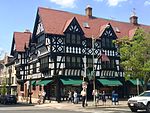Tusculum (Princeton, New Jersey)
1773 establishments in New JerseyHouses completed in 1773Houses in Princeton, New JerseyNational Register of Historic Places in Mercer County, New JerseyNew Jersey Register of Historic Places ... and 2 more
New Jersey Registered Historic Place stubsUse mdy dates from August 2023

Tusculum is a country estate on Cherry Hill Road in Princeton, New Jersey, built in 1773 for John Witherspoon, president of Princeton University and signer of the Declaration of Independence. It is named after the Roman town of Tusculum, which was home to the country villa of Marcus Tullius Cicero. In 1793, the property was made available for purchase as a result of John Witherspoon's declining age, and was sought after by many refugees. The property was often visited by George Washington and his wife, Martha, during Witherspoon's tenure as president of Princeton University. In 2013 the home was sold for $5.5 million.
Excerpt from the Wikipedia article Tusculum (Princeton, New Jersey) (License: CC BY-SA 3.0, Authors, Images).Tusculum (Princeton, New Jersey)
Cherry Hill Road,
Geographical coordinates (GPS) Address Nearby Places Show on map
Geographical coordinates (GPS)
| Latitude | Longitude |
|---|---|
| N 40.365694444444 ° | E -74.671166666667 ° |
Address
Cherry Hill Road
08540
New Jersey, United States
Open on Google Maps










